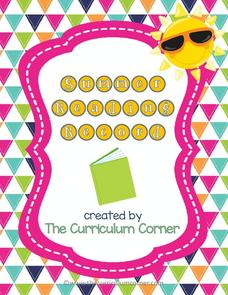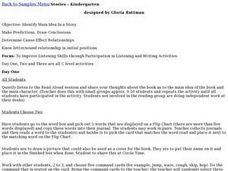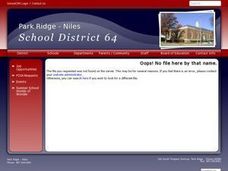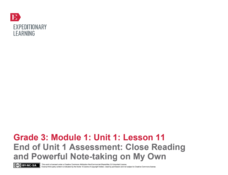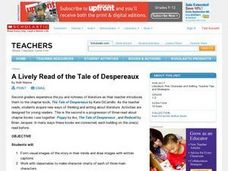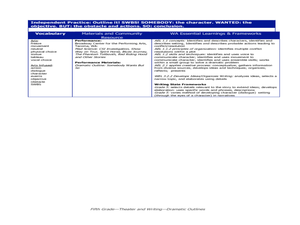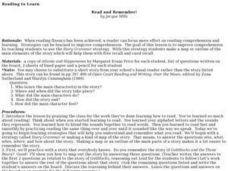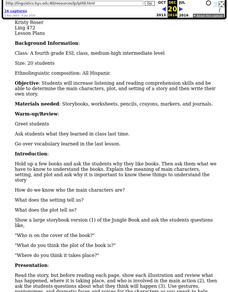Curriculum Corner
Summer Reading Record
No more summer reading lag! Give young readers a set of graphic organizers and worksheets to keep track of the books they read over the summer and to keep reading comprehension skills fresh. The graphic organizers include identifying...
EngageNY
Close Reading of The Boy Who Loved Words: How Do People Build Their Word Power?
Third graders practice the skills of identifying the main message in a story, describing the main character, and sorting the key details of a story into specific categories. The story they read is, The Boy Who Loved Words. Using a...
EdHelper
George Washington's Socks by Elvira Woodruff
A solid, straightforward book report form is an excellent addition to your literature unit. Class members note the main characters, point of view, plot elements, and other important details from a story, adding their favorite part...
Curriculum Corner
Fiction Graphic Organizers
Analyze a fictional text with a four-page packet that explores a story's main character and moral, challenges scholars to ask and answer questions about the text, and to create a story map.
Curated OER
Identify Main Idea in a Story
Help your kindergarteners identify the main idea in a story. Small groups work with the teacher to make predictions and draw conclusions. They are able to determine cause and effect relationships. The lesson is divided into several days,...
Curriculum Corner
Summary Writing
Nineteen stylish worksheets offer lesson ideas and practice opportunities designed to reinforce summary skills. Scholars recall events over the weekend as well as favorite books—main characters, problems, solutions, the beginning,...
EngageNY
Close Reading of Thank You, Mr. Falker: Identifying the Superpowers of Reading
Third graders read excepts from the story, Thank You, Mr. Falker in order to gain practice in understanding an unfamiliar story by focusing on the details. They use a worksheet, embedded in the plan, which directs them to certain...
Curriculum Corner
Fiction Graphic Organizers
Get an in-depth look into a narrative text with a three-page worksheet that examines a story's character—actions, sayings, thoughts, and appearance—setting, and challenges scholars to write a brief summary about what they've read.
K5 Learning
Race Cars
Do you ever get nervous before a big event? A pair of race cars discuss their nerves before tomorrow's race in a reading activity that includes five comprehension questions.
Curated OER
An Author Study on Kevin Henkes
To better understand how the author Kevin Henkes uses the theme of friendship throughout his books, learners engage in several compare and contrast activities. The class reads several Henkes titles and discusses the similarities in...
Mr. Mansour
Ralph S. Mouse by Beverly Cleary
Take an in-depth look into Beverly Cleary's story, Ralph S. Mouse, with a 10-question worksheet that focuses on story elements. Scholars describe the main character, point of view, conflict resolution, and more! Then, conclude with...
EngageNY
End of Unit 1 Assessment: Close Reading and Powerful Note-Taking on My Own
As the final lesson plan in a larger beginning-of-the-year unit to establish routines and teach close reading skills, this plan is designed as an assessment piece. Using the story, The Librarian of Basra, learners independently...
Curated OER
Lively Read of the Tale of Despereaux
Learners create a character map of the main characters in The Tale of Despereaux. After reading the text, students create a character chart based on information they gleaned from the story. They use this information to write a letter...
Curated OER
Dramatic Outlines
Students write about main characters. In this dramatic writing lesson, students brainstorm character ideas. Students create actions and give the character a voice. Students act out the scene in groups and create a final draft.
K5 Learning
A Cold Bear
Who is the main character and how does this character prepare for winter? As learners read a short passage, they think about how the bear is preparing for hibernation and respond to five questions about what they read.
Read Works
Cats in the Catacombs
Fourth graders read a short story and then answer questions based on what they read. Learners are asked to support their answers with evidence from the text.
Curated OER
Nursery Rhymes
Learners recall details of nursery rhyme read by teacher, identify main characters, and demonstrate knowledge of poem by creating concept map about story that includes title, clip art, and changes in font and color.
Curated OER
Read and Remember - Story Grammar
Young scholars use the Story Grammar strategy to outline the main elements of the story which will help them with free recall and cued recall. The strategy includes: identifying the main characters in the story, recalling where and...
Curated OER
Remembering What We Read
Students discover strategies to help them better understand the stories they read. As a familiar story is read to the class, individuals practice answering basic questions about the main characters, settings, problems, etc. while...
Curated OER
Language Practice
The simple instructional techniques described in this plan will help young readers learn and practice basic reading skills and strategies. Before reading, introduce your readers to the meaning of main character, setting, and plot. Then...
Curated OER
Humorous Solutions
Discover with your class the humorous solution that follows tall tales. Elementary learners will discuss the tall tale Paul Bunyan and give ordinary solutions for the problems in the story. They will read Sally Ann Thunder Ann...
Curated OER
James and the Giant Peach Character Study
Every book has a few great characters, but James and the Giant Peach is the only one whose characters travel in a piece of fruit. The class creates T-charts for the main characters of the novel, while reading the book. They write actions...
CPALMS
Point of View: A Close Reading of Two Bad Ants
Chris Van Allsburg's Two Bad Ants provides third graders with an opportunity to examine point of view and how the point of view of others may differ from their own.
Curated OER
Freckle Juice
Students complete activities with the book Freckle Juice by Judy Blume. For this literature lesson, students read chapter one and brainstorm adjectives for the four main characters. They make a page of vocabulary words and...
